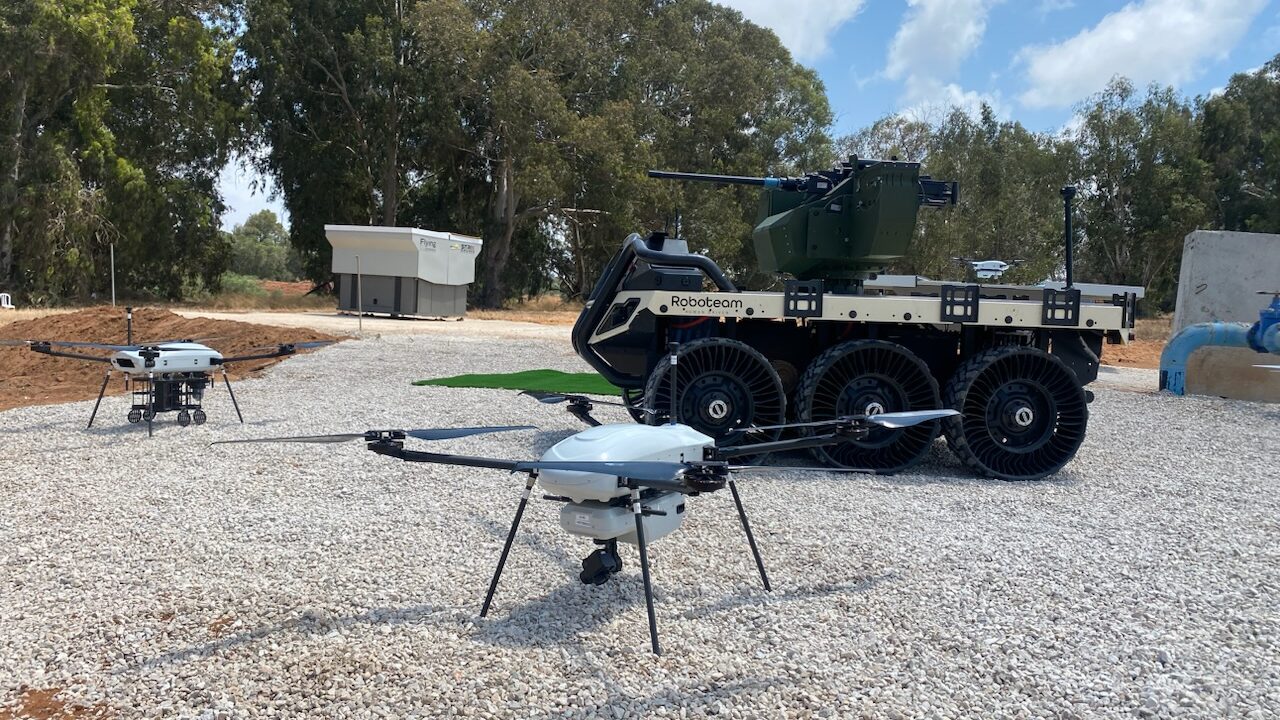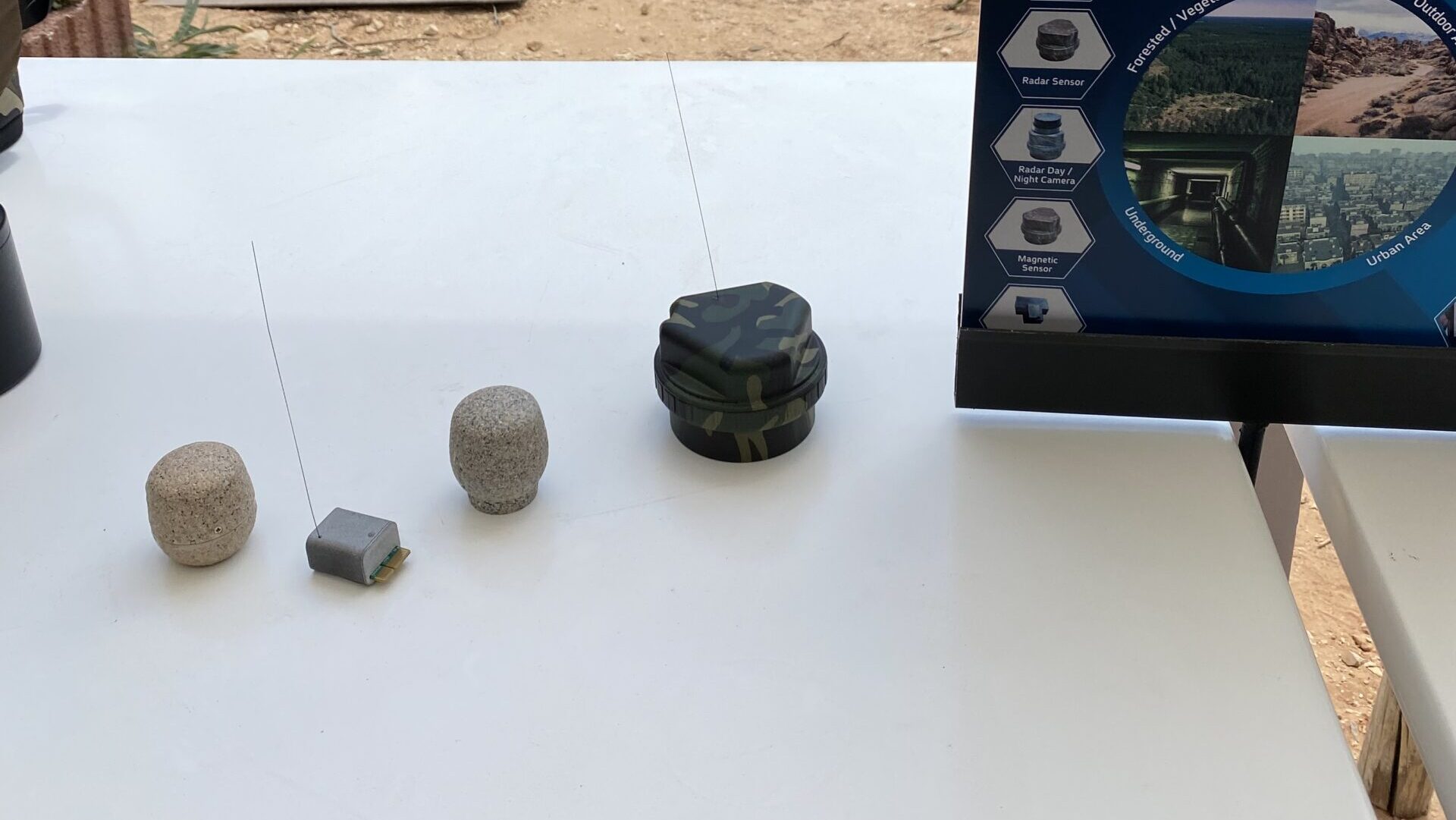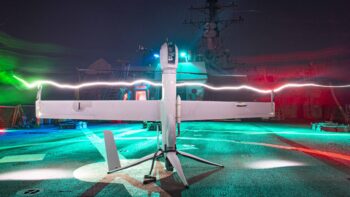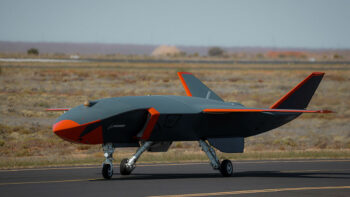
Breaking Defense attended a demonstration of Israel’s Elbit Systems’s autonomous technology in June 2023. (Seth Frantzman / Breaking Defense)
CENTRAL ISRAEL — In a dry field bordered by stands of trees and brush in central Israel are several sleek containers, each roughly the height of a person and several feet wide. They have doors on the top. Two of them open, each revealing a drone inside.
One by one, the large quadcopter drones lift off. Their buzzing soon fades after they rise several dozen meters into the air and fly off to scan a nearby field. Meanwhile two six-wheeled unmanned vehicles roll forward. One of them releases its own drone on a tether and the other ground vehicle, which has a weapon station with a machine gun, prepares to target a potential threat. Each of the systems work together, and the data they gather, including video and where they are in relation to one another, is projected onto a screen at a nearby observation post.
The drones working in combination to observe, investigate, track and target, were part of a demonstration put on by Israel’s Elbit Systems, which hoped to spotlight what unmanned capabilities, teamed with human operators, can achieve. The networked tech, dubbed Legion-X technology, is designed to link variety of unmanned systems, in this case the company’s Thor drones and Rook unmanned vehicle. The company sees the capability as an asset in the cross-domain digital space, knitting together different platforms and units. They describe this as connecting holistic elements into a “digital battlefield.”
RELATED: DoD’s update to autonomous weapons policy accounts for AI’s ‘dramatic’ future role
Elbit says Legion-X is “an autonomous networked combat solution based on robotic platforms and heterogeneous swarms. … Designed to support a wide range of human-machine teaming (HMT) operations, Legion-X enables connectivity and control of air, sea (surface and sub-surface) and land (terrain and sub-terrain) unmanned platforms.” The company says Legion X can serve missions at forward operating bases, at the tactical ground forces level, or in urban warfare scenarios, among other areas.
Most modern armies are going through a process of digitization, and have run up against the challenge of not only coordinating the variety of high-tech assets in the field, but organizing the deluge of information they provide to warfighters. Small drones, especially, have become key fixtures of the modern battlefield for surveillance as well as direct attack, as has played out the conflict in Ukraine.
“We look at current conflict in Europe, the drones have major impact over day to day fighting whether with simple civilian drones in attack or ISR [missions],” said a company representative at the demonstration. Looking forward to the future, the official said, “It’s not just one swarm for a division, it’s a multiplier such as 15 swarms to a division…[and this] is a huge force multiplier to shorten circles of identification and classification and have some kind of effect.”
As part of the demonstration, held on July 10, Elbit Systems presented their vision of this digitized multi-domain battle space. They described their work with the Israel Defense Forces as providing local capabilities in a number of technological areas, such as digital infrastructure, communications, networking and C4I. Israel has been increasingly seeking to bring digital technology to the forefront of its army for the last several years. This is part of its multi-year Momentum Plan modernization program.
RELATED: Meet MAPLE, the brain the will run the UK’s autonomous naval fleet
In the demonstration, the Thor drones dropped small sensors that can gather information like, say, seismic movement to track vehicles or people, or have a day and night camera. The sensors are small, about the size of a fist, and colored to appear like rocks or moss, blending into the terrain. These sensors could be dropped along a border and then wait for an infiltration, enabling unmanned vehicles and drones to investigate. In the demonstration we witnessed a white vehicle being tracked by a drone from above. In another example, the drones tracked a “target” on foot. In the demonstration the person could be seen at a distance, then the drone identified him on the monitor and dropped a non-lethal munition nearby to symbolize how it could confront a threat.

Elbit Systems’s drone-dropped sensors are designed to blend into the background. (Seth Frantzman / Breaking Defense)
Elbit says the system “enhances lethality” and increases mobility, while minimizing human engagement.
Outside, in Israel’s summer heat beating down on the drones and unmanned vehicles, the company emphasized that all the systems on this field, including Thor, the smaller Magni-X drones can fit into a backpack for transport, and the Rook vehicle are all “proven and operational with customers around the globe.” The drones performed several missions, including monitoring and tracking a vehicle during the demonstration. The company says the drones could also hover over an area and detect launches, such as mortars, and they can carry a laser designator to tag targets. A different type of quadcopter variation can carry radar and a camera to help perform counter-UAS missions.
The drones also do autonomous takeoff and landing, and Elbit said Legion X can direct the drones to land at their container-based launch stations based on details such as battery life left in the drone. Elbit’s presenters provided examples of how this might work in the field, such as a base having drones on station continuously, cycling in and out of their charging container in a kind of rotation, saving many man hours along a border or protecting soldiers in a dangerous area. Part of the idea is to make missions, including active tracking, more autonomous to keep the human operator in the loop but to reduce the cognitive burden, the company says.
At the demonstration, one presenter envisioned pushing that concept further, including potentially allowing the system to be operated by voice. Elbit claims it has reached a unique situation where the technology has advanced beyond the need, meaning their experience with the technology is helping customers build doctrines and concepts of operations (CONOPs), helping them learn how to create MUM-T scenarios.






















